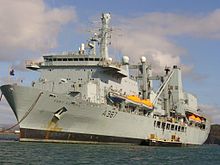This is an old revision of this page, as edited by Trappist the monk (talk | contribs) at 16:10, 13 October 2017 (WPSHIPS: sclass redirect fixes; using AWB). The present address (URL) is a permanent link to this revision, which may differ significantly from the current revision.
Revision as of 16:10, 13 October 2017 by Trappist the monk (talk | contribs) (WPSHIPS: sclass redirect fixes; using AWB)(diff) ← Previous revision | Latest revision (diff) | Newer revision → (diff)
Combat stores ships, or Storeships were originally a designation given to ships in the Age of Sail and immediately afterward that navies used to stow supplies and other goods for naval purposes. Today, the United States Navy and the Royal Navy operate modern combat store ships. The Sirius and Template:Sclass-es (for the US) and the Template:Sclass- and Template:Sclass-es (for the UK) provide supplies, including frozen, chilled and dry provisions, and propulsion and aviation fuel to combatant ships that are at sea for extended periods of time. Storeships should not be confused with fast combat support ships or tenders.
Storeship

Both the United States and the United Kingdom used stores ships in the War of 1812. In both the Mexican–American War and in the American Civil War, captured enemy prizes that were not considered "warlike" enough to be sold for prize money often became stores ships for a naval force operating where no friendly ports are nearby. USS Fredonia took part in the Baja California Campaign in the Mexican–American War. In both the Spanish–American War and the Filipino War the US Navy acquired the stores ship USS Celtic and other similar vessels to serve in its Asiatic Squadron.
Combat stores ship
Six combat stores ships operated by Military Sealift Command provide supplies, including frozen, chilled and dry provisions, and propulsion and aviation fuel to United States Navy combatant ships that are at sea for extended periods of time. Combat stores ships do not carry ammunition for resupply.
Combat stores ships provide underway replenishment of all types of supplies, ranging from repair parts to fresh food, clothing and mail via tensioned cargo rigs and CH-46 Sea Knight helicopters or their commercial equivalents. Combat stores ships are being replaced by more capable class such as the Template:Sclass-s in the US Navy.
Former combat stores ships

Three ships were transferred from the British Royal Fleet Auxiliary to MSC in 1981–83: USNS Sirius on January 18, 1981; USNS Spica on November 5, 1981 and USNS Saturn on December 13, 1983. Five Navy Template:Sclass-s were transferred to Military Sealift Command in 1992–94: USNS Concord on October 15, 1992; Mars on February 1, 1993; San Diego on August 11, 1993; San Jose on November 2, 1993 and Niagara Falls on September 23, 1994. San Diego was deactivated on December 10, 1997 and Mars was deactivated on February 12, 1998. Sirius was sold in 2005, Spica was used as a target ship and sunk in 2009 and Saturn was used as a target ship and sunk in 2010.
See also
References
| This article does not cite any sources. Please help improve this article by adding citations to reliable sources. Unsourced material may be challenged and removed. Find sources: "Combat stores ship" – news · newspapers · books · scholar · JSTOR (June 2008) (Learn how and when to remove this message) |
| Naval ships and warships in 19th and 20th centuries | |
|---|---|
| Aircraft carriers | |
| Battleships | |
| Cruisers | |
| Escort | |
| Transport | |
| Patrol craft | |
| Fast attack craft | |
| Mine warfare | |
| Command and support |
|
| Submarines | |
| Miscellaneous | |
| Related | |